Bigfoot’s Killer-N 1102 Wireless Networking vs. the World
by Jarred Walton on August 10, 2011 10:38 AM ESTTesting Signal Range
Throughput and latency are only two elements of wireless performance. Another important metric is how far a device can be from the router/access point before it drops the signal. For the Linksys E4200 router, we tested 2.4GHz and 5GHz performance with the other radio disabled (since we didn’t want the 5GHz capable laptops switching to 2.4GHz when the signal got weak). The routers were located in my office (one at a time) and I proceeded to walk out the front door with each laptop, closing the metal door behind me. It’s about 40 feet from the router to the front door (not in a direct line), and then I walked down the driveway and out into the street. I’ve created plots showing where I walked and how far I could go with each router and laptop combination. We’ll start with the Netgear results.
The vast majority of the laptops started having connection issues just past the end of my driveway. In fact, only two laptops did noticeably better, and one of those was only just barely better. The Intel 1030 maintained a connection about 20 feet further out than the other wireless devices, though throughput was understandably low (less than 5Mbps). The clear winner however is the Intel 6300. The third stream is almost certainly helping here with MRC, and perhaps the antenna and/or drivers have something to do with the performance as well. Regardless of the reason, the 6300 holds onto the wireless signal a good 60 feet farther than the 1030, and about 80 feet farther than the other wireless devices.
Moving to the Linksys E4200 and using the 2.4GHz radio, the results are substantially better than with the Netgear, thanks to a more powerful radio. Intel’s 6300 again goes the farthest before dropping out, reaching over 200 feet, likely thanks to the three spatial streams/antenna chains. The Atheros and Intel 1030 place second, just ~15 feet shy of the 6300, and Bigfoot’s 1102 and Realtek’s 8188CE are another ~15 feet behind the Atheros. Given the performance elsewhere, we weren’t particularly surprised to see Intel’s 6230 having the lowest coverage area, but it was a surprise to find that the ASUS K53E didn’t reach as far as the Clevo W150HR. Even though the K53E has worse coverage, keep in mind that it still works well in my entire yard and most of the neighboring houses—the latter point being good or bad, depending on whether you like sharing your wireless network.
When we shift over to a 5GHz signal, range drops significantly, providing even less coverage than the Netgear router. Higher frequency signals don’t propagate nearly as far, which can actually be beneficial for home environments—if all of my neighbors were using 5GHz wireless networks, I’d be lucky to see much less connect to any of them! This is one reason all the 5GHz capable cards perform so much better on a 5GHz network: lack of interference from neighboring networks (and microwaves, cordless phones, etc.). Of course, if you want a larger coverage area, even the worst result on 2.4GHz is about twice as far from the router as the best 5GHz result. Interesting to note is that in 5GHz testing, the Bigfoot 1102 actually has the best throughput out to near the end of my drive, pushing over 30Mbps until the last 5-10 feet. The cutoff point for 5GHz is really abrupt, and again that’s either good or bad depending on your intended use.
If reception at the limits of your wireless signal is important to you, the Intel 6300 appears to be the best bet (though potentially other 3x3:3 solutions might post similar results). However, we also need to consider throughput. Even though all of the devices technically maintained a 2.4GHz signal to the end of my driveway, I consider ~10Mbps of throughput to be the cutoff point for my purposes. In that case, right about where the red vehicle is parked is where I’d start getting irritated on the Netgear router, and maybe to the end of my driveway with the Linksys—except for the Intel 6300, which can go another 40 feet or so before dropping below 10Mbps. In general, even though some of the cards went farther before dropping the connection (or losing packets), throughput is much lower beyond the (metal) front door. All of the cards manage about 20-40Mbps inside the house, but close the front door and that quickly drops to 10-20Mbps. While that’s still faster than most Internet connections, latency starts to increase as well and periodic dropped packets become a concern.













52 Comments
View All Comments
zephon85 - Wednesday, August 10, 2011 - link
Any words on the impact of the different wifi adapters on notebook battery life? Would be quite good to know how much (if any) time you gain by using different wireless cards...Gigantopithecus - Wednesday, August 10, 2011 - link
I could be wrong but given the upper limit on mini-PCI and mini-PCIe power capacity, I'd assume differences between cards on the same interface would be negligible in the real world. You might be able to demonstrate small statistically significant differences between cards using large sample sizes and very rigorous, controlled testing, but that's an enormous amount of time and effort to show that card X yields 5-6 more minutes of battery runtime than card Y.JarredWalton - Wednesday, August 10, 2011 - link
I'll cover the battery life question in the laptop review; I didn't actually take the time to perform those tests yet. I don't expect much of a difference, as WiFi adapters are usually pulling less than 250mW, but we'll see.Souka - Wednesday, August 10, 2011 - link
I'll put my $.02 in.Different cards have different drivers....each with their own defaul power settings.
Unless all the various options are taken into account, it can be really hard to get a apples-2-apples comparison of power needs.
But I agree to a point, the wi-fi power draw is really low compared to drive, memory, cpu, gpu, and LCD power needs.
Kinda think of driving a car with the antenna up vs down.... yes it does make a difference, but not much.
My $.02
:)
SquattingDog - Wednesday, August 10, 2011 - link
Just to post on this - Wireless being on or off can make a huge difference to battery life on notebooks - so some testing between cards could definitely be good. Eg on a Netbook I have (Asus n10jc), I typically get around 30 - 45min more battery life with wifi OFF.In saying that, since upgrading from a 54mbps wifi network to a 300mbps wifi network, I have seen no difference in battery usage on the machine (connects at 300Mbps now).
JarredWalton - Wednesday, August 10, 2011 - link
True, but you're looking at a netbook that idles at around 7W. A reduction in power draw of .25W would be a lot more noticeable on that than on a full laptop that's drawing 12-15W minimum.Souka - Wednesday, August 10, 2011 - link
with wi-fi on you may have a fair amount of network activity going on...which also increases the draw by the cpu/drive/mb/etcanyhow...good points all! :)
philosofool - Wednesday, August 10, 2011 - link
Wireless networking isn't something I really keep up on, so I don't know much past the various 802.11 names. What, forexample, does 3x3:3 mean and why might I like that more than some other configuration?A5 - Wednesday, August 10, 2011 - link
From Page 1 of the review:"While we’re on the subject, let’s clarify what the MIMO numbers mean. When we’re talking about a 2x2:2 part, the first digit is the number of transmit chains, the second is the total number of receive chains, and the third is the total number of data streams supported. It’s possible to have a 3x3:2 device, for example, which would use the extra transmit and receive chains to improve SNR (Signal to Noise Ratio), but the number of streams cannot be more than the larger of the transmit/receive chains (so 2x2:3 isn’t possible, but 2x3:3 is)."
Theoretically, a 3x3:3 device offers 3x the bandwidth of a 1x1:1 device.
GeorgeH - Wednesday, August 10, 2011 - link
Thanks for the review, it looks like my bias against everything "killer" will have to be adjusted a bit. While I'm still not sure that the performance difference is terribly meaningful, neither is $20 in most laptops.